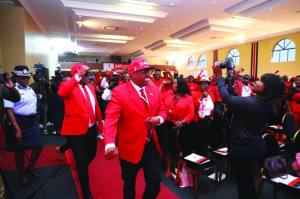At the intersection of Queens Road, Independence Avenue and Pula Circle, opposite the Roman cathedral church, on the south eastern side of the Gaborone main mall, lies this country’s treasure, the National Museum and Art Gallery (NMAG).
Undeniably, NMAG is multidisciplinary. It is constituted of the nation’s museum, the African Modern Art, the National Art Gallery, the Octagon Gallery, and the National Botanical Garden: here, representation is a broad church! But what has previously been a hub for daily visits by tourists, students, artists, residents and researchers, has remained closed for years as it has been the site of unending construction work.
With its shuttering on account of the current pandemic, followed by the country’s complete shutdown, and the eventual gradual reopening of many places of public convenience and interest, it is hard to imagine how visitors to this iconic place have fared or better still, if they have found an alternative location to visit. After all, NMAG has for decades served as a site for the interaction of its visitors with, and their appreciation of, our collective heritage and inheritance through some of this nation’s best visual arts and humanities.
For most nations, bricks and mortar often trace a progression from traditional times to urbanisation, from more simple life to the sophistication of the built environment, and all these reflecting the metamorphosis of dreams to their actualization.
The swift progression of this country from an agrarian lifestyle to middle income status and the rebuilding of NMAG - both take their plot from the substance of national dreams held and their plans implemented.
In fact, this nation’s culture and attitude – of slowing down, endless pondering and staying put – are turned into art and anticipation, of a building construction done in slow motion! But to achieve these, the impending improvement to NMAG requires some honest reckoning with effort and expense; the designs of the proposed building ought to be purposeful; and the journey to its completion demands deliberate strides, despite the length of time it takes to get there. For context: the colossal Norwegian national museum, reopened in June 2022, took eight years and 500 million British Pounds to be constructed. Perhaps more than anything else, this reinforces the notion that, in matters of heritage and inheritance, the counsel of sages is indispensable.
Recall that the first century BC Roman engineer and architect, Vitruvius (c. 80-70 BC – c. 15 BC) advised that buildings should have three attributes: firmitas – the quality of a strong foundation; utilitas – the quality of usefulness; and venustas – the quality named for the goddess of love and beauty. Would that the new NMAG building – delayed as it is (and following in the footsteps of its counterparts elsewhere) - ultimately have all the three qualities.
First impressions often last. So do last impressions. My impressions, formed over the decades I have visited NMAG, are of an underrated public institution that managed to set the standard for mixing the accessibility of this nation’s finest art and history, with creative imagination and intellectual rigor. No other place has yet surpassed it. Actually, to me, as a village youngster, a varsity student, a professional and a father, NMAG was variously a literal place and an idea - for silence, viewing, contemplation, wonder and admiration. Alone or with others, an institution such as NMAG encourages one to engage in a common language - a language of civic engagement, culture and history; of participating in a shared collective of appreciating art, artifacts, pictures, and explanations; and of reckoning with things minute or even monumental and longer lasting than oneself. Any museum is really like an art installation. You can perceive it anyway you will since there is no right or wrong way of experiencing it. Nonetheless, the things on display in a museum and art gallery will often remain so - lifeless and immobile - unless you free yourself to engage with them and thus with those who created or used them. If you engage with them, soon you will learn a necessary discipline, calling you to pay attention - to look anew at your life in a metaphorical light and sense of the things displayed in a museum and art gallery. Anyway, one cannot reminisce about NMAG or its role in our lives without acknowledging and expressing gratitude for the services and commitment of the women and men who, over decades, did their best for this place. For example, our nation’s oldest learned association (significantly, a contemporary of NMAG and thus itself a worthy subject of our heritage), The Botswana Society, always surviving on the margins of indigence, was once permitted to operate, for free, from the precinct of this place. An unsolicited but simple and public expression of gratitude to these people, for this act of other-regardingness should, for present purposes, suffice. The old NMAG may be lost to new construction, but, in my view, it is still retrievable. This is possible as long as its anticipated replacement maintains its intent of chronicling our history and talent and we allow it (as we did to its predecessor) not only to be seen but beheld while it gives itself back to this city and the nation, at the appropriate time.
As the replacement of the old NMAG by the new one takes shape before our eyes and as we acknowledge its remembrance of our heritage and its symbolic celebration of our inheritance, we must accept that, for these reasons, NMAG will always convey meaning about us. We must also accept that through it, we should be able to see the difference between value and values and between mere national subsistence and country fortune. In any event, through routine, small talk about ordinary daily life, done almost everywhere, this country will grow on you. Then, at public places of interest, the melding of the wealth of its heritage with its historical memories, will provide you with a testament to the panoply of the humanities of its people. These, on their own, are its remarkable achievements. They are also the lens by which we can carry our country’s past into the present and the agglomeration of its collections and artistry into the future.
Welcome (back) NMAG!
*Radipati is a regular Mmegi contributor






